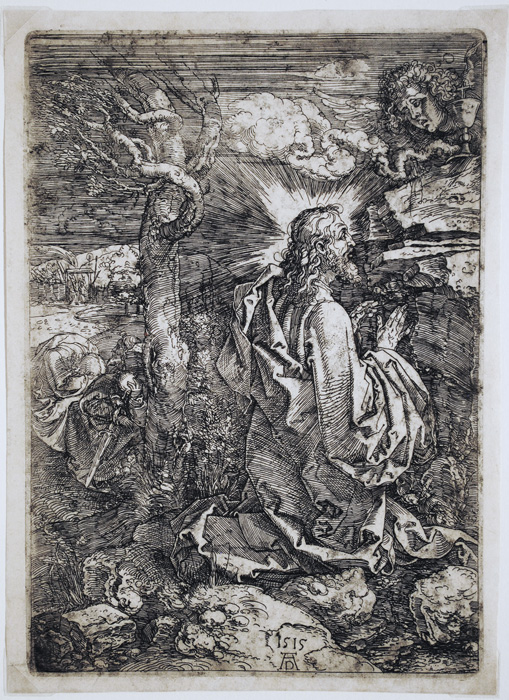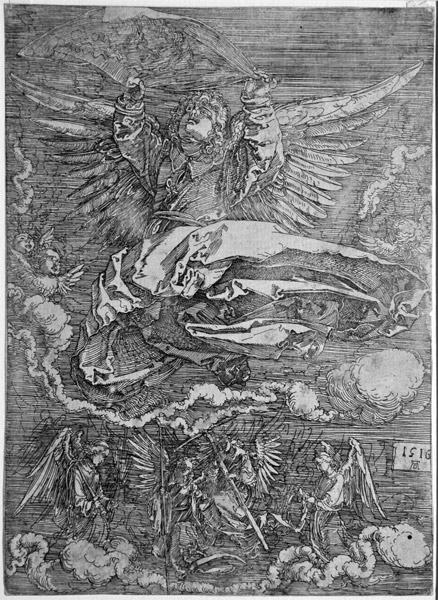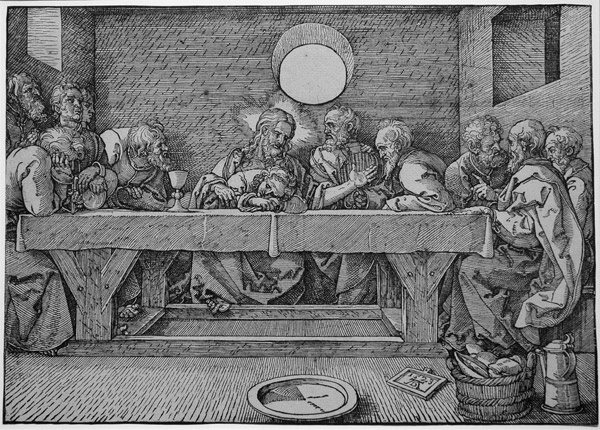Click image for BBB rating
See our Privacy Policy
cool="cool" width="787" height="5613" border="0" cellpadding="0" cellspacing="0" gridx="16" showgridx="showgridx" usegridx="usegridx" gridy="16" showgridy="showgridy" usegridy="usegridy" bgcolor="#99ccff">
|
|
|
 |
|
|
|
|
|
|
Welcome to Spaightwood Galleries, Inc.
120 Main Street, Upton MA 01568-6193
You can follow us on Facebook and Twitter!
We blog regularly on Facebook and announce special events and special sales on both sites.
Old Master Drawings: Albrecht Durer, Other Images from the Passion
|
|
|
|
In The Apocalypse, The Large Woodcut Passion, The Small Woodcut Passion, and The Life of the Virgin, Durer presented long series of works drawing upon the Bible's stories of Christ's passion, the Apocalypse, and, mixing the Gospel According to St. Luke with legends of the Virgin, the Life of the Virgin. After all of these assumed their final form in 1511, Durer was drawn into the service of the Hapsburg Emperor Maximilian I, who commissioned Durer (along with a number of other important German artists) to produce a large Triumphal Arch out of many joined woodcuts. When he began experimenting with etchings, however, Durer returned to the Passion for the subjects of two of his six etchings. Along with a number of engravings of The Virgin and Child, Durer was also drawn in the wars of the Reformation via a book on the Controversy of the Chalice dedicated to him by Andreas Karlstadt, one of Luther's more vehement supporters. Durer's woodcut Last Supper of 1623 displays the chalice quite prominently on the table; the bread plate, empty, is relegated to the floor in front of the table.
Walter L. Strauss in his catalogue raisonnés, Albrecht Durer Woodcuts and Woodblocks (Abaris Books, 1980) and The Intaglio Prints of Albrecht Dürer: Engravings, Etchings, and Drypoints (NY: Abaris, 1981) provides a summary of comments upon each individual work. Strauss's Commentary volume in the Illustrated Bartsch series updates his commentary here. As always, Panofsky's Life and Art of Albrecht Durer (Princeton University Press, 1945, revised editions culminating in the 1971 edition) is crucial for an understanding of the work of this great artist and printmaker.
|
|
|
|
 |
|
|
Sudarium held by two angels (Bartsch 25, Strauss 69, Meder 26 b/d). Original engraving, 1513. Wölfflin called this "The crowning representation of Dürer's Passion series" and observed that "The new face of Christ created by Dürer appears here in its purest form" (Strauss, Engravings, 192). Panofsky observes that "The features of the Saviour bear an unmistakable resemblance to Dürer's own" and adds, "Definitely heraldic in character, the angels are balanced with almost perfect symmetry, yet subtly differentiated in pose and gesture. The Holy Face fastens its eyes on the beholder with hypnotic intensity. Light and dark are subtly graded and more evenly balanced than in the engravings of 1508-1512. This is one of only three engravings by Dürer in the oblong format" (Strauss, Engravings, 193). Like Dürer's Salvator Mundi in the Metropolitan Museum of Art, once you glance at the eyes, it is very difficult to turn away and once you have been held by them, your eyes are immediately drawn back to them (Cardinal Nicolas of Cusa [1401-64], a German and the author of a treatise on Learned Ignorance, had strongly urged this and noted that this could be accomplished by putting the eyes at the perspective vanishing point of the image). Trimmed slightly within the platemark; an old crease is visible just above the plaque containing Dürer's monogram and the date. One of Dürer's masterpieces. Image size: 98x137mm. Price: Please call or email for current pricing information.
On my 27-inch monitoor, this is life-size.
|
|
|
 |
|
|
Christ's Agony in the Garden of Gethsemene (Bartsch 19, Strauss 82, Meder 19 I b-c). Original etching on iron, 1515. A very good Meder I bc impression, formerly in the Gray Collection of Harvard University and the Fogg Art Museum. Durer made his etchings on iron which quickly rusted and stained the paper when the plate was printed. Ours is an impression before the rust. Repaired tear, upper left corner, extending into image. One of Durer's 6 etchings. Winkler calls this "the first successful etching in respect to the pictorial setting. Signed and dated in the plate. One of Durer's most important prints in an early state. Image size: 221x156mm. Price: SOLD.
|
|
|
|
|
 |
|
Christ's Agony in the Garden of Gethsemene (Bartsch 19, Strauss 82, Meder 19 I c). Original etching on iron, 1515. A very sharp Meder IId impression with somewhat unobtrusive rust spots visible across the top and along the sides, where the plate was handled; happily, Jesus, the light emanating from him, and the angel's face, are clear. Overall, the image above is cleaner, but this one is still quite contrasty and strong where Durer wanted it to be strong and contrasty. Jesus prays in the Garden of Gethsemene after the Last Supper that "this cup" (of his crucifixion) might pass, but in response, an angel appears holding the cup and Jesus accepts God's will ("Thy will be done"). One of Durer's 6 etchings. Winkler calls this "the first successful etching in respect to the pictorial setting." Small horizontal ink line in the lower left margin just extending to the platemark (this is not a tear). Printed on a sheet of wove paper, probably at the Reichsdruckerei in the 19th century. Signed and dated in the plate, bottom right-center. One of Durer's most important prints in a late but strong impression. A "very fine Meder b impression" of this etching sold at Christie's (NY) on 1/29/13 for Please call or email for current pricing information. Image size: 223x157mm. Price: Please call or email for current pricing information.
|
|
|
|
|
|
|
According to Christie's commentator, "Dürer made at least two preparatory drawings for this etching. . . . [In the second one,] All the emphasis is on Christ and the apparition of the angel above, while the narrative aspects of the scene, the sleeping disciples, and the soldiers with their lances and torches coming for his arrest are merely hinted at. The whole scene is shown in an intense, nervously flickering chiaroscuro, which heightens the sense of unrest and despair, as Christ says to His Father: "O my Father, if it be possible, let this cup pass from me: nevertheless, not as I will, but as thou wilt" (Matthew 26:39). By further stressing the core of the narrative—Christ's dialogue with God—Dürer created a devotional image in the spirit of the devotio moderna, whose supporters were in search for a personal and immediate approach to God." This is about the time that Dürer became interested in Erasmus, whose portrait he drew (c. 1520) and featured in am engraving(1526). According to his Diary he met Erasmus in Antwerp in 1520 and gave him a set of the engraved Passion. When Luther was condemned at the Diet of Worms and was thought dead, Dürer in his diary appealed to Erasmus to take his place and to carry the banner of salvation to his martyrdom (as cited by Panofsky in his explication of Dürer's egraving, The knight, Death, and the Devil).
|
|
 |
|
|
|
Christ's Agony in the Garden of Gethsemene (Bartsch 19, reduced-size copy). Engraving after Durer's etching. An excellent 16th-century impression on laid paper of one of Durer's most powerful prints. Image size: 202x142mm. Price: SOLD.
|
|
|
|
 |
|
Sudarium spread out by an Angel (Bartsch 26, Strauss 83, Meder 27). Original etching on iron, 1516. A Meder I.bc impression, with most of the scratches not yet visible. Durer made his etchings on iron which rusted and stained the paper when the plate was printed. Ours is a very good impression before the rust. Formerly in the Royal Print Collection, Stuttgart, with their collector's marks on the reverse. Trimmed just inside platemark at top; thread margins sides and bottom. One of Dürer's 6 etchings—rare in this condition. One of Dürer's graphic masterpieces. Panofsky describes this as "a feverish vision, with the pace of the needle accelerated to an allegro furioso.... Space seems to have dissolved into a darkness pervaded by a long wail of lament. Signed and dated in the plate. One of Durer's most important prints in an early state. . Image size: 184x135mm. Price: SOLD .
|
|
|
|
|
|
 |
|
|
The Last Supper (Bartsch 13 copy 1, Strauss 199, Meder 184). Woodcut after Durer, 1523. This horizontal version of The Last Supper differs radically from Dürer's earlier vertical versions. A very deceptive copy (we purchased it as the original!) on laid paper in very good condition. Unlike the original (see below), the edge of the plate touches the bottom border line. Image size: 209x290mm. Price: Please call or email for current pricing information.
|
|
|
 |
|
|
The Last Supper (Bartsch 13, Strauss 199, Meder 184a). Original woodcut, 1523. One of Dürer's last major prints, this version of the Last Supper differs radically from earlier versions. This print is illustrated in almost every study of Dürer's art. An excellent impression of a beautiful print. Image size: 209x290mm. Price: SOLD.
|
|
|
Spaightwood Galleries, Inc.
To purchase, call us at 1-800-809-3343 (1-508-529-2511 in Upton MA & vicinity) or send an email to spaightwood@gmail.com.
We accept AmericanExpress, DiscoverCard, MasterCard, and Visa.
We also accept wire transfers and paypal.
For directions and visiting information, please call. We are, of course, always available over the web and by telephone (see above for contact information). Click the following for links to past shows and artists. For a visual tour of the gallery, please click here. For information about Andy Weiner and Sonja Hansard-Weiner, please click here. For a list of special offers currently available, see Specials.
All works are sold with an unconditional guarantee of authenticity (as described in our website listing).
Go back to the top of this page.
Visiting hours: Saturday 10:00 am to 5:00 pm and Sunday noon to 6:00 pm and other times by arrangement.
Please call to confirm your visit. Browsers and guests are welcome.
|
|
|
|
|
|
|
|
|
|
|
|
|
|
|
|
|
|
|
|
|
|
|
|
|
|
|
|






